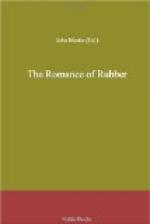CHAPTER 6
PLANTATION LIFE
The moist but very hot climate which rubber trees require is found only in a zone around the world between the parallels of latitude thirty degrees north to thirty degrees south of the equator. Within this zone there have been found more than 350 rubber bearing trees, shrubs and vines. For this reason this zone is called the Rubber Belt. As most of the rubber used commercially is gathered from trees growing within a zone extending from ten degrees north to ten degrees south of the equator, this latter zone is sometimes called the Inner Rubber Belt.
If you will trace this belt on a map of the world you will see that it includes the Amazon region which produces more than three-quarters of the wild rubber used in manufacturing. Most of South America’s wild rubber is obtained from Brazil, the remainder from Bolivia, Peru and Venezuela. Now continue the belt across the Atlantic Ocean to Africa, where you will strike the Belgian Congo which produces a small quantity of wild rubber. Partly owing to the careless manner of gathering and partly to the fact that it is not originally of as good quality as Brazilian rubber, Congo rubber is not as valuable for manufacturing as Brazilian. Then complete the circle by following the belt across the Indian Ocean to Ceylon and the East Indies which contain the great rubber plantations where most of the rubber used to-day comes from.
To establish a rubber plantation requires very careful planning. The choice of a site is of first importance, for the planter must find a locality having a moist climate with an evenly distributed rain-fall where the temperature throughout the year does not fall below seventy degrees Fahrenheit, and where there is protection from the wind. There must also be, of course, access to a steady labor supply and a convenient shipping port. As the proper climate is a tropical one, there is usually dense jungle to be cleared away. Immense trees and thick bushes, rank straggling weeds and vines form an almost impenetrable jungle. To turn such a place into a garden spot means a genuine battle against jungle conditions. But gradually trees, shrubs and undergrowth are torn out and burned, laying bare the rich soil ready for the plow of the planter.
Meantime the rubber seedlings have been sprouted in nurseries. When the ground is ready they are carefully taken up and transplanted to the holes which have been made for them in the field where they are to be permanently planted.
Though the growth of the trees is very rapid, sometimes as much as twenty feet in the first year, there are five years of anxious waiting and guarding against winds and disease before they are ready to be tapped and so begin to reward the planters. At first the yield of a tree is only about one-half pound of rubber a year, and this increases so slowly that it is many years before it amounts to as much as ten pounds a year. The highest yield ever recorded was given by one of the original trees set out in the gardens at Heneratgoda, which gave ninety-six and one-half pounds in one year.




